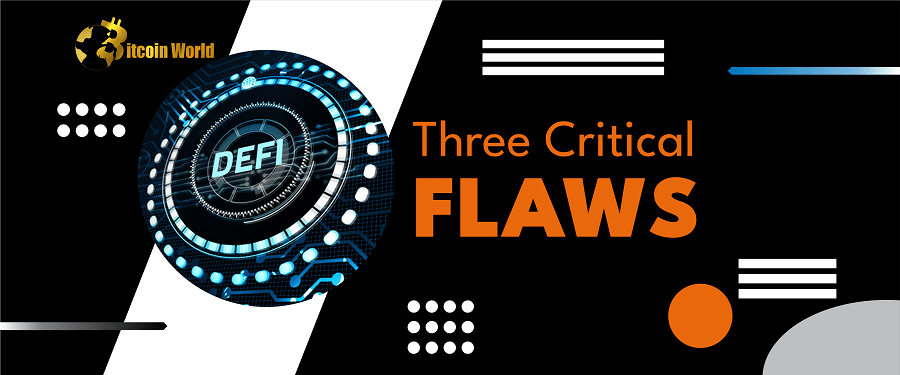Remember the DeFi summer? The explosion of decentralized finance protocols promised a revolutionary shift in how we interact with financial services. But lately, the buzz has quieted. Has the DeFi dream stalled? Let’s dive into the current state of DeFi and understand why the initial excitement has cooled down.
The Numbers Don’t Lie: A Significant Drop
The data paints a clear picture. Since its peak in December 2021, the total value locked (TVL) in DeFi has plummeted by a staggering 77.6%. To put that into perspective, even the broader crypto market’s decline of 71% hasn’t been as severe in this particular metric. This significant drop raises some important questions about the sustainability of many DeFi projects.
Why the Decline? Three Key Flaws
So, what’s behind this downturn? According to DeFi analyst ‘CyrilXBT’, the struggles of many DeFi protocols can be attributed to three critical shortcomings:
- Poor Risk Management: Think of DeFi protocols as intricate financial systems. Without robust risk management, they become vulnerable to shocks and exploits.
- Insufficient Revenue: Like any business, DeFi protocols need sustainable income to thrive and offer real value.
- Excessive Leverage: Over-borrowing can create a house of cards, leading to catastrophic collapses when market conditions change.
Risk Management: A Recipe for Disaster?
Imagine a bank without proper security measures. That’s the risk many DeFi protocols faced. The year 2022 was riddled with hacks, cross-chain bridge attacks, and smart contract vulnerabilities, resulting in a staggering $3.9 billion in losses. Strong risk management isn’t just a nice-to-have; it’s a fundamental requirement for any DeFi platform to survive and build trust.
The Revenue Riddle: Can DeFi Protocols Be Profitable?
Generating sustainable revenue is the lifeblood of any successful venture. As the analyst aptly put it, “One of the most frequently cited reasons for DeFi protocols struggling is their inability to generate sustainable income that adds meaningful value to the platform’s ecosystem.” Protocols that rely on unsustainable tokenomics, often characterized by high inflation rates, face a significant challenge. When the supply of tokens increases rapidly without a corresponding increase in demand or utility, the value tends to drop, causing liquidity to flee the platform.
Leverage: A Double-Edged Sword
Leverage can amplify gains, but it can also magnify losses. In the DeFi space, over-leveraged positions proved to be a major vulnerability. Protocols that allowed users to borrow heavily against their crypto assets were particularly susceptible. When market downturns occurred, these leveraged positions were often liquidated, contributing to further price drops and instability. The collapses of major players like Celsius and Three Arrows Capital (3AC) serve as stark reminders of the dangers of excessive leverage.
The DeFi Landscape is Shifting: Who’s Leading the Pack?
While many protocols have struggled, the top of the DeFi leaderboard has seen a significant reshuffling. Interestingly, Lido, a platform focused on liquid staking, has emerged as the dominant force, surpassing stablecoin pioneer MakerDAO.
| DeFi Protocol | Market Share | Total Value Locked (TVL) |
|---|---|---|
| Lido | 13.8% | $6.6 Billion |
| MakerDAO | – | $6.4 Billion |
| Curve Finance | – | $4.3 Billion |
Lido’s recent success is largely attributed to the growing popularity of liquid staking derivatives, particularly in anticipation of Ethereum’s Shanghai upgrade. Curve Finance remains a significant player, holding the third-largest share of the DeFi ecosystem. However, the overall TVL of the entire DeFi space currently stands at $47.6 billion, a substantial 74% decrease from its peak.
What Does the Future Hold for DeFi?
Despite the current challenges, it’s important to remember that the underlying principles of DeFi – transparency, accessibility, and decentralization – still hold immense potential. The current downturn can be seen as a necessary correction, weeding out unsustainable projects and highlighting the importance of robust fundamentals.
Actionable Insights for the Future of DeFi:
- Focus on Enhanced Security: Protocols must prioritize robust security measures to prevent hacks and exploits. This includes rigorous smart contract audits and proactive risk management strategies.
- Develop Sustainable Revenue Models: Moving beyond inflationary tokenomics towards models that generate real value and utility is crucial for long-term viability.
- Promote Responsible Leverage: Protocols need to implement mechanisms to prevent excessive leverage and mitigate the risks associated with it.
- Community Governance and Transparency: Engaging the community and ensuring transparent operations can foster trust and resilience.
- Focus on Real-World Use Cases: Exploring and developing practical applications for DeFi beyond speculation can drive wider adoption.
The Road Ahead
The DeFi landscape is evolving. While the hype of the past may have subsided, the underlying technology and its potential remain. The protocols that learn from the mistakes of the past, prioritize security and sustainability, and focus on delivering real value are the ones most likely to not only survive but also drive the next wave of DeFi innovation. The journey may be bumpy, but the future of decentralized finance is far from over.
Disclaimer: The information provided is not trading advice, Bitcoinworld.co.in holds no liability for any investments made based on the information provided on this page. We strongly recommend independent research and/or consultation with a qualified professional before making any investment decisions.


